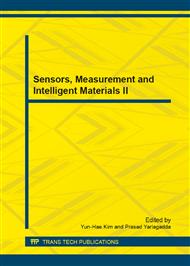p.144
p.148
p.156
p.161
p.167
p.173
p.177
p.184
p.188
Research on Self-Calibration of Circular Artifacts
Abstract:
In order to solve the problem of poor performance of the traditional calibration algorithm , the paper proposed a mathematical model under the constraints of nonrotating and nonscale error ,which solved the defects of inconvenience and expensiveness. Moreover, the mathematical model was obtained through the correlation equation based on the least squares method. Meanwhile , the paper discussed the impact of random noise on the model ,and it was simulated by Matlab. The result of the simulation shows that the model can separate the system error of circular artifacts accurately whether the existence of random noise or not. The result of this paper on expanding the application areas of selfcalibration is of great significance.
Info:
Periodical:
Pages:
167-172
Citation:
Online since:
December 2013
Authors:
Price:
Сopyright:
© 2014 Trans Tech Publications Ltd. All Rights Reserved
Share:
Citation:


